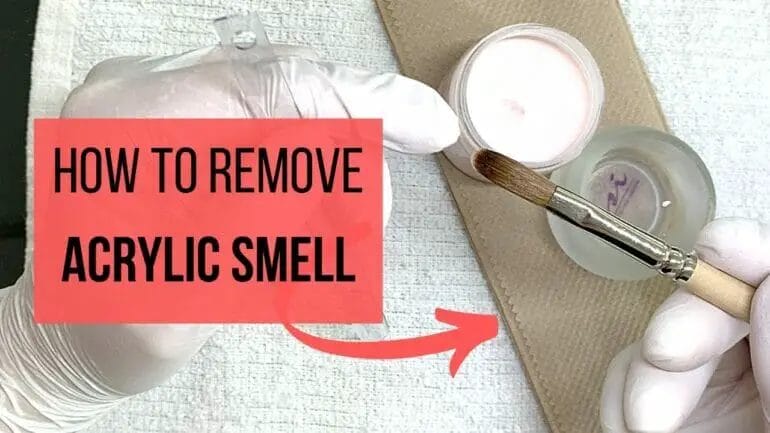Acrylic paint is a popular choice among artists and DIY enthusiasts due to its versatility and vibrant colors. One common concern is whether acrylic paint has a strong odor. The good news is that acrylic paint is generally low in odor compared to other types of paint, making it more pleasant to use in indoor settings. While there may be a slight odor, it is usually mild and dissipates quickly. This makes acrylic paint a great option for those who are sensitive to strong smells or prefer a more odor-free painting experience.

Understanding the Chemical Composition of Acrylic Paint and its Odor
Acrylic paint is a widely used medium in the art world due to its versatility, vibrant colors, and quick-drying properties. Understanding the chemical composition of acrylic paint is essential for artists, as it not only affects its application and drying time but also its odor.
Acrylic paint is made up of three main components:
- Pigments: These are the colorants that give acrylic paint its vibrant hues. Pigments can be organic or inorganic and are finely ground to create a smooth consistency.
- Binders: Binders are what hold the pigments together and adhere them to various surfaces. In acrylic paint, the most commonly used binder is an acrylic polymer emulsion. This emulsion is made up of polymers, which are essentially long chains of molecules.
- Solvents: Solvents are used to thin the paint, increase flow, and facilitate mixing. In acrylic paints, water is the primary solvent. When the paint dries, the water evaporates, leaving behind a solid film of acrylic polymer.
Now, let’s delve into the topic of odor in acrylic paint. Acrylic paints are generally known for having a low odor compared to other types of paints, such as oil paints. The low odor is attributed to the water-based nature of acrylic paints, as they contain primarily water as the solvent.
However, there might still be a slight odor associated with acrylic paints. This odor is mainly due to the presence of additives and volatile organic compounds (VOCs) in the paint formulation. Additives such as preservatives, defoamers, and flow agents can contribute to the overall odor of the paint.
It’s important to note that the odor of acrylic paint is relatively mild and typically dissipates quickly once the paint has dried. Adequate ventilation is always recommended when working with any type of paint to minimize exposure to potentially harmful fumes.
Furthermore, many manufacturers have taken steps to reduce the odor and VOC content in their acrylic paints. They have developed low-odor formulations and VOC-free alternatives, making them safer for artists and the environment.
In summary, acrylic paint is composed of pigments, binders, and solvents. The water-based nature of acrylic paints contributes to their low odor compared to other types of paints. However, additives and VOCs present in the paint formulation can still contribute to a slight odor. With advancements in paint technology, many manufacturers now offer low-odor and VOC-free acrylic paints, providing artists with safer options for their artistic endeavors.

Tips for Reducing or Eliminating the Smell of Acrylic Paint
If you’re an avid painter or frequently work with acrylic paint, you may be all too familiar with the strong odor that often comes with it. The fumes from acrylic paint can be unpleasant and bothersome, especially if you’re working in a small or poorly ventilated space. Fortunately, there are several tips and tricks you can try to reduce or eliminate the smell of acrylic paint. In this section, we will explore some effective methods that can help you enjoy a more pleasant painting experience without the nuisance of strong odors.
1. Opt for Low-Odor Acrylic Paint
One of the easiest ways to reduce the smell of acrylic paint is to choose a low-odor or odorless paint option. Many paint manufacturers offer low-odor acrylic paint varieties that are specially formulated to emit fewer fumes during the painting process. These paints are often labeled as “low VOC” or “odorless” and can be a great alternative for those sensitive to strong odors. When shopping for acrylic paint, be sure to look for these specific labels to find the most suitable option for your needs.
2. Paint in a Well-Ventilated Area
Proper ventilation is key when it comes to minimizing the smell of acrylic paint. If possible, try to paint in a well-ventilated area such as a room with open windows or a studio with a ventilation system. Good air circulation will help dissipate the fumes and prevent them from lingering in the space. Additionally, you can use fans or portable air purifiers to further improve air circulation and reduce the concentration of paint fumes in the room.
3. Use a Respirator Mask
If you’re particularly sensitive to the smell of acrylic paint or if you’re working with a large quantity of paint for an extended period, wearing a respirator mask can provide an extra layer of protection. Respirator masks are designed to filter out harmful particles and fumes, including those emitted by acrylic paint. Look for masks that are specifically rated for paint fumes and ensure a proper fit for maximum effectiveness.
4. Keep Paint Containers Closed
When not in use, make sure to tightly close the lids of your paint containers. This will help prevent the paint fumes from spreading throughout the room and minimize their impact. Keeping the containers sealed will also help prolong the shelf life of your paint and prevent it from drying out too quickly.
5. Work in Short Sessions
Instead of working on a painting marathon, consider breaking your painting sessions into shorter periods. By working in shorter sessions, you allow for air circulation and the dissipation of paint fumes in between. This can help reduce the overall smell and make it more manageable, especially if you’re working in a confined space.
6. Use an Air Purifier
An air purifier with a HEPA filter is an excellent investment for any painter looking to minimize the smell of acrylic paint. These purifiers effectively capture and filter out airborne particles, including paint fumes, helping to clean and freshen the air in your workspace. Place the air purifier near your painting area for optimal results.
7. Clean Up Properly
After you’re done painting, it’s crucial to clean your brushes, palettes, and other painting tools thoroughly. Store them in airtight containers or bags to prevent the lingering smell of acrylic paint from permeating your storage area. Additionally, clean any spills or drips immediately to minimize odors. Using vinegar or baking soda mixed with water can be an effective natural solution for removing paint odors from surfaces.
8. Utilize Odor Absorbers
If you’re still struggling with the smell of acrylic paint, you can try using odor absorbers to neutralize the odor. Place bowls of white vinegar, activated charcoal, or coffee grounds around your painting area to absorb and eliminate the paint fumes. These natural odor absorbers can help neutralize the smell and leave your workspace smelling fresh.
9. Take Breaks in Fresh Air
Lastly, don’t forget to take regular breaks outside or in a well-ventilated area. Stepping outside for fresh air can help clear your senses and provide relief from the smell of acrylic paint. Taking breaks also allows you to assess the odor levels in your workspace and make any necessary adjustments to minimize the smell.
In summary, the strong smell of acrylic paint can be overpowering and unpleasant. By following these tips, you can reduce or eliminate the smell, creating

Health Effects and Safety Measures when Working with Acrylic Paint
Acrylic paint is a popular choice among artists due to its versatility and vibrant colors. However, it is important to be aware of the potential health effects and take proper safety measures when working with acrylic paint.Health Effects of Acrylic Paint
While acrylic paint is generally considered safe to use, prolonged exposure or improper handling can lead to health issues. Here are some potential health effects associated with acrylic paint: 1. Irritation and Allergic Reactions: Direct contact with acrylic paint can cause skin irritation, redness, and allergic reactions in some individuals. People with sensitive skin or pre-existing skin conditions may be more susceptible to these reactions. 2. Respiratory Issues: Inhaling acrylic paint fumes or dust particles can irritate the respiratory system. This may lead to symptoms such as coughing, wheezing, shortness of breath, or asthma-like symptoms. 3. Eye Irritation: Splashes or accidental contact with acrylic paint can cause irritation and redness in the eyes. In severe cases, it may even lead to corneal damage.Safety Measures when Working with Acrylic Paint
To ensure your safety and minimize the risk of any health issues, it is essential to follow these safety measures when working with acrylic paint: 1. Work in a Well-Ventilated Area: Always paint in a well-ventilated space or use a ventilation system to ensure proper air circulation. This will help minimize the inhalation of fumes and dust particles. 2. Use Personal Protective Equipment (PPE): Wear protective gloves, goggles, and a respirator mask when handling acrylic paint. This will protect your skin, eyes, and respiratory system from any potential hazards. 3. Avoid Skin Contact: Use gloves or barrier creams to prevent direct contact between the paint and your skin. If paint does come into contact with your skin, wash it off immediately with soap and water. 4. Avoid Inhalation: When working with acrylic paint, try to avoid breathing in the fumes or dust particles. Use a respirator mask specifically designed for paint fumes if necessary. 5. Protect Your Eyes: Wear protective goggles or safety glasses to shield your eyes from accidental splashes or spills. In case of eye contact, rinse your eyes thoroughly with clean water and seek medical attention if irritation persists. 6. Proper Waste Disposal: Dispose of any unused or excess paint properly according to local regulations. Avoid pouring paint down the drain or into the environment. 7. Hygiene Practices: Wash your hands thoroughly with soap and water after working with acrylic paint. Avoid eating, drinking, or smoking while handling paint to prevent accidental ingestion. 8. Store Paint Properly: Ensure that containers of acrylic paint are tightly sealed and stored in a cool, dry place. This will prevent the paint from drying out and releasing harmful fumes. 9. Seek Medical Attention if Needed: If you experience any persistent symptoms or allergic reactions after working with acrylic paint, seek medical advice promptly. In summary, while acrylic paint can be a wonderful medium for artistic expression, it is important to prioritize your health and safety. By following these health precautions and safety measures, you can enjoy the creative process while minimizing any potential risks associated with working with acrylic paint.Odorless and Low-Odor Alternatives to Traditional Acrylic Paints
Acrylic paints are a popular choice among artists due to their versatility and vibrant colors. However, many traditional acrylic paints come with a strong odor, which can be bothersome for those with sensitivities or for working in enclosed spaces. Luckily, there are now odorless and low-odor alternatives available in the market. In this section, we will explore some of these alternatives that allow you to enjoy all the benefits of acrylic paints without the overpowering smell.
1. Water-Based Acrylic Paints
Water-based acrylic paints are a great option for artists looking for odorless alternatives to traditional acrylic paints. These paints use water as a thinning agent instead of solvents, making them safer and more comfortable to work with. With water-based acrylics, you can achieve similar effects and results as traditional acrylic paints while eliminating the strong smell.
One popular brand of water-based acrylic paints is Golden Artist Colors. Their High Flow Acrylics and Fluid Acrylics lines offer a wide range of colors and excellent pigmentation. These paints have a smooth consistency, allowing for easy application and blending.
Another noteworthy brand is Liquitex, which offers a range of water-based acrylic paints that are low-odor and easy to use. Their Soft Body Acrylics and Heavy Body Acrylics are highly pigmented and provide excellent coverage.
2. Acrylic Gouache
Acrylic gouache is a hybrid paint that combines the properties of traditional gouache and acrylic paints. It offers a matte finish and vibrant colors, similar to gouache, but with the added advantages of acrylic paints such as durability and waterproofness. Acrylic gouache paints are also known for their low odor, making them a good alternative for artists seeking a more pleasant painting experience.
Holbein Acryla Gouache is a popular brand known for its wide range of colors and excellent opacity. These paints have a smooth, creamy consistency and can be easily reactivated with water, allowing for effortless blending and layering.
3. Open Acrylics
Open acrylics are a unique type of acrylic paint that offers extended drying time. Unlike traditional acrylic paints that dry quickly, open acrylics have a longer working time, allowing artists to blend colors and work on their artwork for an extended period. This extended drying time also contributes to a reduction in odor, providing a more pleasant painting experience.
Golden Open Acrylics is a well-known brand that offers a range of colors in their open acrylic line. These paints retain the characteristic properties of traditional acrylic paints, such as intense color, flexibility, and water resistance, while providing a longer drying time and minimal odor.
4. Atelier Interactive Acrylics
Atelier Interactive Acrylics are another excellent choice for artists looking for low-odor alternatives. These paints have a unique formulation that allows them to dry slightly slower than traditional acrylics, extending the working time. They also feature a re-wetting ability, which means you can reactivate the paint even after it has dried, allowing for additional blending and adjustments.
Atelier Interactive Acrylics come in a wide range of colors and are known for their smooth consistency and excellent color stability. They are a popular choice among artists who prefer a more controlled painting process and desire a reduced odor.
If you are sensitive to strong odors or prefer a more pleasant painting experience, there are plenty of odorless and low-odor alternatives to traditional acrylic paints available. Water-based acrylic paints, acrylic gouache, open acrylics, and Atelier Interactive Acrylics are just a few examples of these alternatives that offer excellent color quality and versatility while minimizing the unpleasant smell. Explore these options to find the perfect odorless acrylic paints that suit your artistic needs and preferences.
FAQs
Does acrylic paint smell?
Acrylic paint usually has a mild, low-level odor that is not overpowering. However, some people may be sensitive to the smell. To reduce the smell, ensure proper ventilation by opening windows or using a fan, and consider using low-odor or odorless acrylic paints.
Conclusion
In conclusion, while acrylic paint does have a distinct odor, it is generally considered to be less strong and offensive compared to other types of paint. The smell of acrylic paint is often described as mild and non-toxic, making it more suitable for indoor use. However, it is always recommended to have proper ventilation when working with any type of paint to minimize any potential respiratory irritation. Additionally, there are low-odor and odorless acrylic paint options available in the market for those who are more sensitive to the smell. Overall, with proper ventilation and precautions, the smell of acrylic paint can be manageable and should not deter you from expressing your creativity.
